There are so many interesting things to consider when counting, however having taught upper elementary and middle school, I have never taken the time to consider these complexities. After doing a Counting Collections activity in Kindergarten on Friday, I saw so many foundational ideas being constructed in simply counting a set of things. As I planned and implemented the activity with Kindergarten teachers Jenn and Michele, I felt a lot of the ideas in this post by Joe Schwartz, including the amazing counting conversations, surfacing.
The lesson plan seemed simple: Give the students a set of things to count. Walk around, watch, listen, and ask questions. From that simple plan, our planning conversation was filled with so many questions since this group of students had never done a counting collections activity. After watching this Teaching Channel video, we began asking ourselves: What is important about the set of things when students count? What tools do we make available? How do we keep them from grabbing every tool because they can? What questions do we ask? What numbers are appropriate for each student? How will they record their thinking? What is the end idea we want students to leave thinking about? This post would be so long if I included our decisions on all of this, but I am happy to answer any questions in the comments if you are curious. Not that they were the right or wrong answers, but our decisions.
We decided to keep the sets the same object, same color to avoid students sorting by color. I think it will be an interesting conversation in the future about what matters when we are counting, but for the first time, we wanted to really see what they did with counting without distractions and how they recorded their count. We made available big cups, small cups, ten frames and plates.
These are some of the interesting things we observed students considering when counting and explaining their count…
Choice of Tool(s)
Students had to consider the size of the object and size of the set to decide on the tool they felt would best organize their set. We saw groups switch because their object did not fit in or on what they originally chose. Some groups liked the plates to stack and organize their count because the ten frames took up too much space on the table. I wish I got a picture of one group who used the yellow and blue ten frames in the picture below…they put their full tens on the blue and their ones on the yellow and were able to articulate that statement as their counting strategy.
Counted vs Not Counted
This is where the tool they chose came into play again. Some groups chose to put the uncounted objects in one cup and count by 1’s into another cup. For these groups we saw a lot of losing track of count. We anticipated this in our planning and decided to ask them if there was another way they could count to help keep track of their numbers or if there was a way to organize their objects so we could see how they counted when we walked up.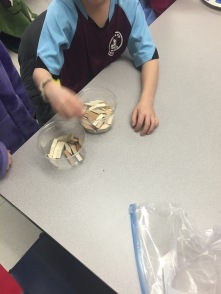
Another group drew a line on their first plate and said it was for ones they counted and ones they hadn’t, however as the crayons took up too much space, they moved to putting 10 on a plate.
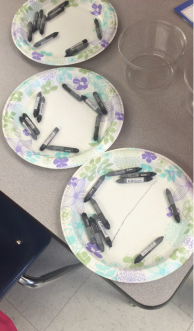
Do We Even Have to Count?
This group got away with not really doing any counting at all until they combined their end organization. They filled a ten frame and poured it into cups. It was interesting because in the first, smaller set they counted just before this larger one, they filled all 10 frames on their table (in the pic under Choice of Tool). As it took up too much space this time, they switched.
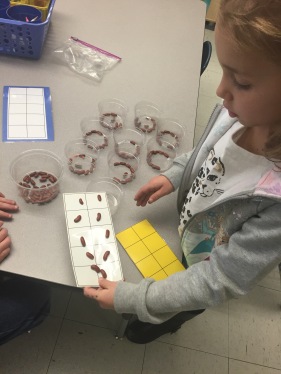
How We Count vs How We Record The Number Of Objects We Count
This group put 10 on each plate and started to label each plate by 10s, however on the second plate one partner wrote “20” because she was counting, 10, 20, 30..etc. Her partner corrected her and said there were not 20 on the plate. You can see the scratched out mark on the plate and hear it here.
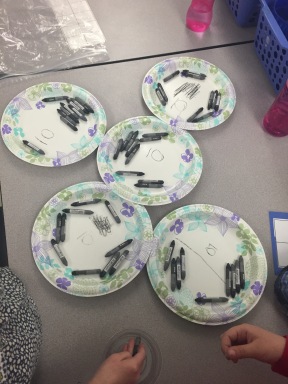
Adjusting for Larger Sets
This group kind of blew my mind. Their second set was 225, so they decided to put ten beans in every box of the ten frame. They were then even able to articulate the fact they knew 10 groups of 10 is 100. You can listen to them here. This is my first try with YouTube, so if this doesn’t play, please let me know in the comments;)
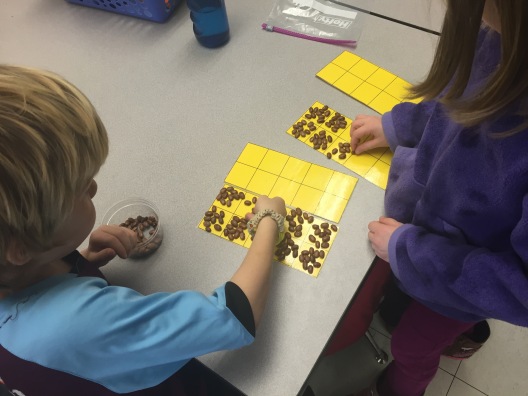
Recording Our Counting
This was one of the areas where we were so curious to see what happened! Jenn and Michele do a ton of Number Talks and journal writing, however during the Number Talks, the teachers does the recording. We didn’t know if they would draw everything they counted or be able to record it more abstractly with equations or would they do both? We did see a mix of all of this!
When Counting and Number of Things Counted Gets Jumbled…What To Do?
We had the groups share their first set (which were all in the 50s) and one group picked up on a counting strategy and way to organize that got a bit jumbled in the end. This group put 10 on the first plate, 20 on the second, 30 on the next, etc. It was like counting by 10s but now there were not 10 on each plate. When I asked how many were on each plate, they were able to tell me that the number they recorded way was the number of beans on each plate and when I asked how many were there altogether, they said they didn’t know. This is where they ended:
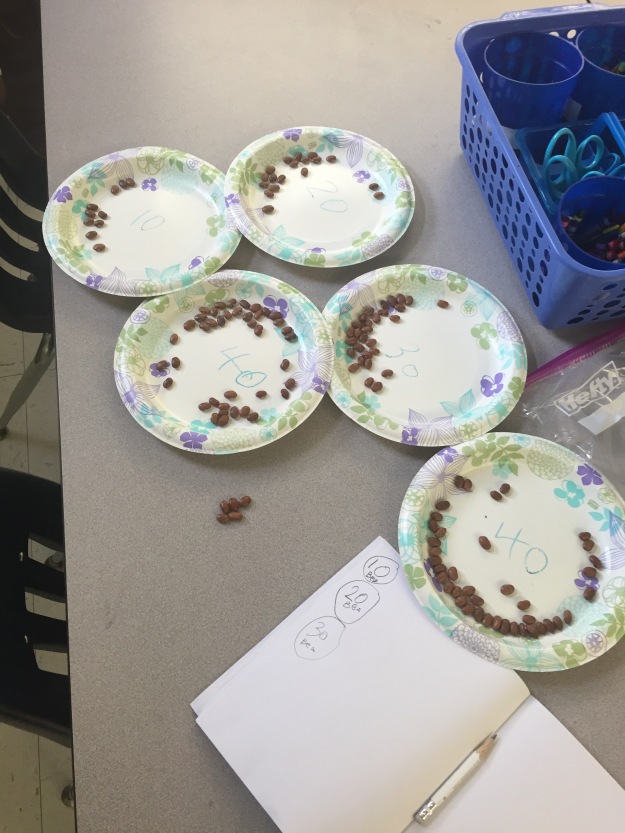
So, where would you go from here with this group? Our feeling is to pull out the ten frames and put the beans from each plate on them because the students are really great at seeing and counting by 10s in this way. Would this be an interesting thing for the whole class to explore?
So many things to think about when counting! I love to think about how these ideas of counting and combining groups keep showing up in the work I am doing in all of the other grade levels! If we could really do this more and give students space to make sense of groups and how and why they work, wouldn’t it make so much of their future math work so much more accessible? If students really understood these foundational ideas, would we need to spend the time (and money) on intervention programs in later grades that are addressing these very same things?
Counting is Complex but we can structure ways to allow students to be successful in thinking about all of these ideas!








Awesome post! Thanks for sharing your experiences with counting collections. I’ve also begun to explore counting collections with a first grade class. We’ve done 3 sessions so far and,like you, have been amazed by what we’ve seen and heard. However we have (so far) limited the number in each collection to between about 50-110 with the intention of increasing amounts as the kids get more adept at counting. It’s impressive to see kindergartners counting such big collections!
The thought of different colored objects confusing the counting process was something we didn’t think about beforehand. But it did come into play. Groups counting a set of different colored cubic inch cubes, for example, sorted by color and then had a hard time counting the set.
What we’ve been most happy with is the way the kids have improved how they record their counts. Also, we’ve been amazed by their persistence. It has not been uncommon to see a student or students at work at counting and recounting a single collection for an entire class period. That alone makes this activity well worth the it takes to prepare the collections for the kids.
LikeLiked by 2 people
Thanks Joe! I love hearing about the different colored objects because that is exactly what we thought they would do. I think it is an interesting conversation to have with students…Did sorting them help you count? Did the color matter in telling how many were there?
We did have groups with different set numbers. Some groups had a count in the 50s, the majority were in 130-170 and only that one group had over 200. That is another great thing about this activity, the ability to differentiate so easily!
We are thinking of putting it as a math center as well, have you tried that in the 1st grade rooms?
LikeLike
I really like the way you’ve had students record their thinking here Kristin. Most of the time I’ll have students count sets and record the quantity, but I haven’t put much thought in the recording of their counting strategy. I like this!
The video you embedded in the “Adjusting for Larger Sets” is top notch. Thanks for including this piece. This is a solid post with lots to chew on!!!
LikeLike
Thanks Graham! Jenn, the classroom teacher, does journaling with these kiddos a lot and they love it! When we planned, we watched this video: https://www.teachingchannel.org/videos/skip-counting-with-kindergarteners which brought up the recording and we really liked it!
That 10 groups of 10 blew my mind, so cool!
LikeLiked by 1 person
So interesting to think about the students who put 10 on the first plate, 20 on the second, etc. I wonder how they would respond if asked how they could figure out how many there were altogether? Maybe they would suggest another strategy like putting 10 on each plate and counting by tens or using ten frames. If so, it would be neat to have a photo of their original strategy and compare the outcomes. This would be neat for the class to discuss. They used tens in each strategy. Would they be able to talk about how the first strategy used multiples of tens and how this was different…. and maybe harder to count.
Thanks for sharing this. Very interesting to think about!
LikeLike
Thanks Nancy! I know, that was a mix of how they count by 10s and how many are on each plate. They could tell me how many were there but when I asked about altogether, they were at a loss. I think ten frames could be the way to go here with the whole class!
LikeLike
I am curious about what they would say about the difference with using the ten frames.
LikeLike
When working with high school students, we realize there are sometimes gaps and misunderstandings that lead to a weak foundation upon which we have difficulty building algebra skills. Going all the way back to counting and the thought processes behind it I would be curious to see the math strugglers do this to help us get insight to their thought processes. Too simplistic?
LikeLike
Funny running into you here, Jennifer – we met at the Simmons/Hoover High math meeting!
I have been thinking a lot about similar ideas, of going back to the beginning of fractions and working for a conceptual understanding using pictures, word problems, unifix cubes, anything I can think of.
I am very worried about kids feeling babied. I have tried to use manipulatives to remediate solving equations, but the student I worked with just felt embarrassed and left feedback on the semester reflection to that effect.
I think it all depends on how you frame the activity. If it appears that the teacher is taking a step backwards because the kid or the class is “behind” in some way, I can see kids rejecting the new activity. If the teacher instead poses the activity as something that might seem childish but in fact can lead to deeper insights into algebra, it might work.
I’m still chewing on this idea, but I see a lot of promise.
LikeLike
Thank you Jennifer and Kent! I completely agree Kent, it is so much more difficult as students get older to not make them feel bad about themselves or babied. While I would love to see all of our intervention efforts in the earlier grades so these remediations weren’t as necessary in the upper grades, it is not the reality. This activity was so nice because it was easily differentiate-able. It leaves me wondering if there is a way to take the activities we do, where students struggle, and make them differentiated to meet their needs without making them feel inadequate? Like with fractions, is there a way to incorporate fraction bars into the mix without the ones who need it knowing they are there because of them while at the same time making them purposeful for the students who don’t need that concrete manipulative? So many questions! I would love to talk more about how we could do this for students no matter the grade level, so keep me posted on activities and we can brainstorm this more!
LikeLike
This turned out great Kristin! Really summarized it nicely for me and made me even more excited to move forward with the counting collections journey! I am planning this week to open it up to the whole group about how they organized their counting. Th idea of putting 10 on one plate, 20 on another, and 30 on another idea… I think it will be a great discussion! Thanks to all who replied too! It was great reading your posts as to how the idea of counting is complicated and spans all the way to high school… Something to consider in the primary grades when we are teaching the not so easy art of counting!
LikeLike
Thank you for sharing the recordings of their counting. That is such a vital piece. I love the kiddos that recorded the 10 + 10 + 10… and then had an organized way to represent those groups of 10 (dots like on a die). Comparing why those students decided to record that way to those that recorded it with groups of tens (organized by 1’s) would be an interesting conversation to have.
Being able to record their physical representations are hard for kindergarten kids. These students did a wonderful job. Abstracting to numbers verses using a picture that matches exactly is a huge step.
LikeLike
Pingback: Obsessed With Counting Collections | Math Minds
Pingback: Formative Assessment | Math Minds